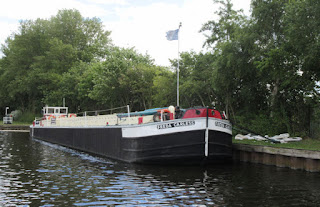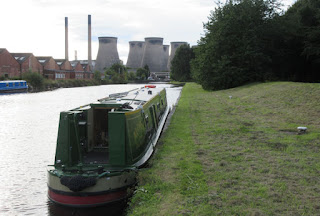The day began really bright - and, yes, we did manage a better picture of our mooring than last evening!
Mike walked the short distance down to the lock, across the footbridge, with the old lock cottages now used as private residences, to a short row of small shops in Ferrybridge. Although rather more of the shops are now closed than we had seen on StreetView, Mike did manage to get the three items he was aiming to buy.
As it is really a flood lock, we did not have much of a rise but Christine did have to clamber somewhat to get back on the boat afterwards as there is not proper lock landing.
The next stretch is a wide part of the River Aire - strangely wider than the part we did yesterday which is further downstream. We passed under first the modern concrete road bridge and then the older stone bridge that previously carried the Great North Road.
We gradually came around the huge Ferrybridge Power Station site - although the huge cooling towers still dominate the skyline they no longer fulfil their proper role as the station is now closed as part of the move away from coal generation of electricity. At one time the River Aire was busy with barges carrying coal from the various nearby mines. A unique system, called Tome Pudding Boats, was one of the methods used. A string of up to twenty almost square tubs were linked together in a chain with just a single pusher tug. (A few remaining examples can be seen at the museum in Goole which we visited five years ago). When the boats arrived at the power station they were unloaded by this huge mechanism which picked up a boat, turned it over and emptied all of the contents onto the awaiting conveyor system. In the 1960's we did actually pass one string of Tom Puddings but it is a long time since they operated.
Nature has rapidly reclaimed much of the river bank and most of it is now very pleasantly green.
Just occasionally a pit waste heap can be seen, with nature taking a little longer to cover it.
Some people know how to make a real bijou picnic site!
A couple of former colliery loading basin can just be spotted with a narrow access onto the river.
Eventually we arrived at Bulholme Lock. Above the lock is moored Freda Carless, an historic boat that is being preserved by National Historic Ships UK. It was built in 1964 in Knottingley and finally ceased service in 2005. It carried around 360 tones of cargo, generally sand.
At Castleford we called at the service point for a full range. Christine had done two loads of washing as we cruised along this morning so filling the water tank took quite a while. Mike attempted to find out from CaRT customer services when Woodnook Lock would be open. Last night we received by email a stoppage notice that a stalk was broken - we later found out that this means the bar that is used to pull up the top gate sluice paddles. However the person answering was no more informed than we already were.
So we set off through the flood lock - this time the gates were open at both ends.
Out then onto the wide open cross roads where right is to Leeds, left to a large weir (so not navigable) and ahead to Wakefield which is where we were planning to go. Since we really did not want to go to Leeds, we opted to press on to Woodnook and hope to find out more when we got there.
We moored below the lock and just caught a couple of the people who had been investigating - unsuccessfully - the problem. All that they knew was that somewhere underground the stalk is catching on something and becoming stuck. However, one of them thought that the lock could still be operated manually and that a lock keeper was being arranged for a short perios this afternoon. He suggested we try again to contact Customer Services. This time we had a more helpful person who took time find out more information. When she came back the the answer much more encouraging - we should be able to pass through between 2.30 and 3.30 this afternoon. Since it was now just after 1.30, and lunch was still not complete, this was cheering news.
A short while later a large CaRT work boat came upstream and tied onto the lock landing. It was due to pick up some new balance beams from the Stanley Ferry workshop and had been told that he would be penned through at 2 o'clock! In addition, the next two locks were being manned to see him through and we could tag along behind!
The lock was already empty so when the lock keeper arrived he could open the gates and let us both in. (everything apart from the top sluices was working mechanised) However, the manual gate paddles had obviously not had a lot of use and a further team of three was needed to persuade them to open.
They must have been over-enthusiastic and they over-wound one paddle such that it came adrift inside the winding gear! Some dismantling and heavy engineering (ie a heavy hammer and a wrecking bar!) were deployed. The gate paddles are nt a speedy way to fill the lock and it was almost 45 minutes before the top gates could be opened and we were both on out way again.
As promised another member of staff, travelling by van, had the next two locks ready and waiting and closed up after we had left.
At Stanley Ferry workshop the work boat tied up alongside several large piles of gates and timbers being continuously watered. This is to condition the wood before the gates are then immersed in the canal for the next 25 years or so.
Immediately after the aqueduct we came alongside with some difficulty in order to fill up our fuel tank. Boats were moored in the way and the wind was quite strong and insisted that we really ought to be on the other side of the canal. Eventually, Christine manged to jump off only to discover that the boatyard is closed today - open in in the morning! Just as well we were not down to our last few drops.
We continued on down the straight cut to Broadreach from where it was not far to Wakefield where we we planned to moor tonight. However, half way along we suddenly saw a wave from one of the moored boats - it was Mark from nb Ellis - he has followed our build blog and we have followed his. (You should see a link to his latest entry in our Blog List column on the right)We just had to stop to chat - easier said than done since we were already just passed and the wind was again less than helpful - this time blowing in quite the opposite direction (both wrong at the time!) Of course, we had to show off our respective boats with guided tours and detailed examination of which features work or not!
This took some time before we set off once more - Mike was too busy with steering the boat away from the moorings and only managed a photo as we left Ellis behind! By now it was rather late to press on to our planned overnight stop so we pulled in at the end of the visitor moorings just before Broadreach Lock. It is, however, good to put a reality to a fellow blogger!
11.8 Miles - 7 Locks





















































